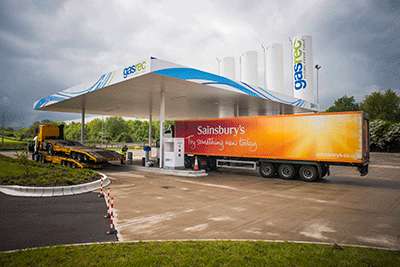
Gasrec has bet a small fortune on the future of natural gas as a road transport fuel. Chief executive Rob Wood tells Steve Hobson that the odds are moving in its favour.
For those in the road transport industry with long memories, the era of gas-powered vehicles has dawned before – but proved to be false. Will things be different this time, as diesel is not only more expensive now but is being demonised for its carbon dioxide, particulate and NOx emissions?
Gasrec is betting that the time has come for natural gas – methane – to capture a significant share of the road freight fuels market, and despite the current low volume of sales continues to invest in its UK gas refueling network. Without an adequate network of gas stations open to all vehicles, most hauliers will be reluctant to buy gas vehicles, so in the absence of government support beyond a pledge to hold down duty on gas someone has to be brave enough to spend money ahead of the curve.
“We have invested heavily in the UK gas market,” says Gasrec chief executive Rob Wood (pictured). “We’re funded by a New York-based family which believes, when you look at the financial and environmental case, that this is something that will happen.”

Our meeting takes place at Gasrec’s flagship open-to-all gas station close to the Daventry International Rail Freight Terminal, where many of the UK’s top 3PLs have large sites. The station, which opened in 2013, is currently undergoing a major refurbishment, with five new dispensing pumps being installed amongst other upgrades. The station has refueled up to 210 vehicles in a day, and vehicles operated by DHL and Brit European fill up during our visit.
Wood has been converted to gas, having started out at BP, well before it began calling itself ‘Beyond Petroleum’. BP did indeed eventually begin to look at alternatives to oil and that is how Wood got involved in gas as a road fuel.
“I was with BP for 24 years in a variety of roles and got my first job selling diesel to truck drivers, funnily enough,” he says. “Then I got involved in the gas business and moved to Gasrec in 2013.”
Lower emissions
Compared with diesel, natural gas vehicles can reduce NOx emissions by around 70%, particulates by 90% and CO2 by up to 90% when using biomethane.
Another lesser known but very harmful emission generated as a by-product of diesel exhaust after-treatment is nitrous oxide (N2O). While N2O is also known as laughing gas this is no laughing matter - it is an aggressive greenhouse gas that is over 300 worse than CO2.
“The AdBlue treatment to suppress NOx is producing a by-product, N2O,” says Wood. “This came out of tests done by LowCVP last year at Millbrook. They’ve seen it in buses and now they’re beginning to see evidence of it in trucks. N2O is really bad, and it doesn’t need much for it to have a massive impact on global warming. On Euro-6 diesels, it’s not regulated so it’s not measured.
“But when you look at the chemistry of NOx treatment, you’re going to produce N20, there’s no question. It’s just a question of how much.”
Because burning gas does not require exhaust after-treatment to meet Euro-6, no N2O is produced. A gas engine just has a simple catalyst to ensure no methane escapes to atmosphere unburnt. Gas engines are also quieter, easily meeting the Dutch Piek low noise standard.
Price advantage
But quite apart from the environmental benefits of switching from diesel to compressed (CNG) or liquefied (LNG) natural gas, at current prices it makes financial sense too. But cynics fear that the government will hold down duty on gas until operators have invested in gas trucks, then hike up the duty (see panel below).
“The pump price today of gas is around 40% lower than diesel, underpinned to some extent by a government guarantee to maintain a 50% duty discount on diesel,” says Wood. “The government has pledged to keep it the same until 2024. At that point, it will be reviewed. The case we always made to government is that we need a duty differential versus diesel while the industry is starting up.
“In the long run, because gas engines are simpler than diesel engines, there is no reason why you need to have that differential. The duty incentive in my mind is purely temporary in order to get it all moving and get the basic infrastructure in place.
“What the government should do however is knock the heads of the top 20 logistics firms together and tell them they must do something to reduce emissions or we will legislate.”
Gas trucks last longer
While the initial cost of gas vehicles is currently considerably higher than their diesel equivalents – mainly because volumes are much smaller – the lower cost of the fuel means the payback period is anywhere between one and five years depending on the type of operation. But Wood argues that the current model of three-year first life ownership or contract hire needs to change.
“The OEMs have effectively encouraged operators to change vehicles every three or four years,” he says. “That’s great from a vehicle manufacturer’s perspective, because they sell more vehicles.
“With gas, you have to do something different. Because it’s a high capital cost, operators would benefit by keeping it for longer. There will be some dilemmas for the industry as it starts to realign around a different business model as the market moves more towards gas vehicles.
“The vehicle manufacturers will sell fewer trucks and they won’t have the same secondary markets overseas.”
Gas is also a cleaner fuel for the vehicle, another reason gas trucks should last longer.
“Anecdotal evidence from people who’ve been running gas buses for quite some time is that engine wear is imperceptible. They talk about the engines being absolutely spotless inside,” Wood says. “The only downside is that you have to change the oil more often with gas engines as they run at higher temperature and the lubricant technology hasn’t caught up yet.
“But I mentioned that to one of the oil companies and they said ‘we’ve got a gas lubricant which works well at high temperature’. Maybe the industry hasn’t quite woken up to all the opportunities yet.”
Not just an urban solution
Wood believes that gas has a place in both urban and long distance operations. An Iveco gas-powered 4x2 Stralis recently ran 837 miles from John O’Groats to Lands End on a single tank of LNG while several city bus and refuse collection fleets have switched to gas.
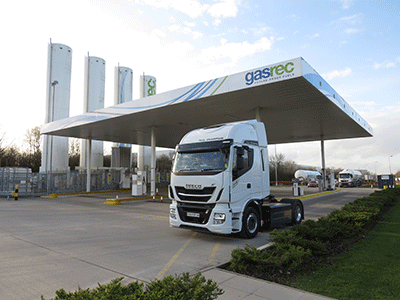
“In town centres, it’s all about air quality,” says Wood. “On trunking operations, it’s all about cost. A lot of our customers are retailers and they are not immune to the air quality argument.”
Hydrogen has also been touted as a zero emissions alternative to diesel, and in a few places such as London and Aberdeen bus operators are being heavily subsidised to trial it, but Wood says that for the foreseeable future gas will be a much cheaper option.
“The problem with hydrogen is that it is really expensive,” he says. “The refueling stations are expensive, and the buses - I don’t know the precise number - but people talk about £1m a bus. The cost of hydrogen is a country mile more expensive than any competing technologies. No question that it will come down in price but not anytime soon.
“Gas is the only practical alternative in the heavy transport sector.”
OEM gas trucks
So Gasrec and other gas refueling networks are playing their part to make natural gas available to more operators. Crucially truck manufacturers are also now doing their bit by introducing factory-built gas vehicles that retain the full OEM warranties with acceptable horsepower and range.
“There are a number of manufacturers making trucks in the 300 to 340hp power range, often used for refuse trucks,” says Wood. “The Iveco Stralis Natural Power puts out 400hp while Volvo and others are soon to introduce ratings of 430 or 450hp in a 6x2 tractor.”
Volvo is working with Westport Technology to develop a more efficient and powerful LNG high-pressure direct injection (HPDI) engine that uses a small amount (around 5%) of diesel to ignite the gas. This avoids the loss of efficiency in spark-ignition gas engines, almost halving the CO2 emissions. HPDI should not be confused with the old dual-fuel technology that was effectively killed off by the recently completed Low Carbon Vehicle Trials.
Iveco also makes gas versions of the Daily and Eurocargo for urban applications but the focus so far has been on heavy trucks and buses.
“The whole conversation three or four years ago was about CO2 reduction,” says Wood. “Nobody really bothered about air quality. If you look at CO2 reduction, it maybe pushes you towards bigger vehicles consuming the maximum amount of fuel.
“But what’s emerged recently is there’s maybe a bigger issue, which is air quality. It changed very quickly.”
But even with this shift in emphasis from CO2 to local air quality, heavy trucks are likely to remain the focus for legislators.
“According to government figures, 6% of road vehicles - buses and HGVs - account for 47% of NOx emissions,” says Wood. “The fact is, if you want to deal with the issue, then deal with the heavy vehicles. They contribute most to the problem.”
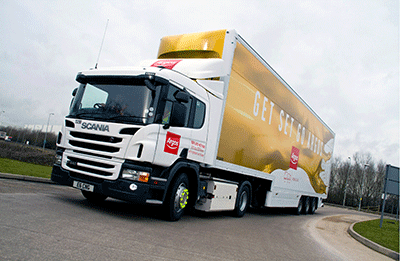
Wood is dismissive of the government’s latest attempt to appease the courts with its feeble air quality strategy, describing it as a “missed opportunity”.
“The air quality plan doesn’t, in any shape or form, target the opportunity of using gas to displace diesel,” he argues. “Particularly at the heavier end, it pretty much ignores the issue. It says, ‘Euro-6 diesel is the solution. Let’s look at cars’.”
Nevertheless, Gasrec is confident that the tide is at last turning towards gas trucks and the technology is moving into the mainstream. Switching refuse collection vehicles to gas already makes financial and operational sense with fleets of 12 or more as the vehicles are back at base every night and it is worth installing a dedicated gas refueling station.
But the open access infrastructure that would enable a haulier to send a gas truck tramping around the UK is not there – yet. Gasrec currently operates two open access fueling stations, at Daventry and Bridgwater in Somerset. It estimates it now has 65% of the gas road fuel market, most of which is supplied through operator-owned dedicated stations.
“In terms of demand, we think by 2025 the market could be 25,000 gas heavy trucks,” says Wood. “Our aspiration is to be satisfying about 30% of that. That would mean we’re refueling about 7,500 vehicles with 300,000 tonnes of LNG. So roughly we’re expecting that to be 10 to 20 refueling stations of this sort of size.
“The trampers will be the last people to move to gas. The first to adopt it will be the guys that are going from the depot out and back in the same day. And, of course, there are a lot of those in places like this in the ‘golden triangle’ where you’ve got these big logistics parks.”
When Gasrec opened its Daventry station in 2013 it was refueling just 35 trucks a day. The company’s investors have stuck with the UK gas market partly though faith and partly because they remain confident the technology’s time has come.
“To some extent, they are doing this because they think it’s the right thing,” says Wood. “But clearly they are looking for a return on their investment. They are staying with it and believe in the business case.”
Bio or non-bio?
Ordinary methane is readily available from the UK’s gas distribution system – it is after all piped to most UK homes and businesses. While it provides substantially reduced CO2 emissions over diesel, it is still a non-renewable fossil fuel. For a truly sustainable alternative to diesel, some operators such as Waitrose are sourcing biomethane, produced from anaerobic digestion (AD) of organic waste, to power their gas trucks.
In theory, biomethane is zero carbon, as the AD process captures methane which would otherwise be released to the atmosphere. In terms of its effect on global warming, methane is 80 times worse than CO2. But demand for biomethane is high, and transport operators are competing with industry and commerce for limited supplies. Photo: Newcastle University
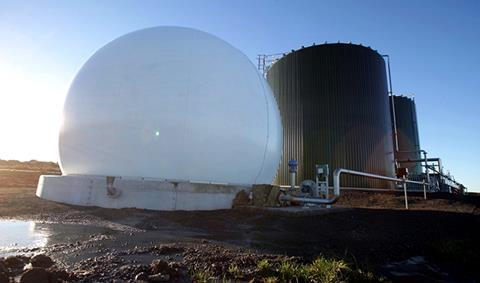
The National Grid estimates that the UK could boost its current output of biomethane from AD tenfold by 2035, but that will require considerable investment in new plant. The government currently subsidises the use of biomethane for heating buildings through the Renewable Heat Incentive, making it even harder for transport operators to secure adequate supplies.
“Everybody is keen to see biomethane substitute for fossil methane, and that’s because of the CO2 advantages,” says Wood. “There is quite a lot of biomethane around. The question is how to use it and how to allocate it. We would argue that in transport, you have few alternatives.”
A DfT consultation closed recently on changes to the Renewable Transport Fuels Obligation (RTFO), which currently requires that 5% of road fuel comes from renewable sources.
“For the relatively recent AD projects, there’s a prospect that all of the gas could go to transport because it will be more attractive,” says Wood. “The RTFO subsidy regime isn’t quite clear. In its last consultation, the DfT was proposing to create an advanced RTFO tier, which is probably going to be for waste-derived fuels, where the subsidy could be set at a high level. But nobody knows what the price is yet. My interpretation is they want it to happen and now they’ve got a mechanism for making it happen.”
The price of gas
Comparing the cost of gas and diesel is difficult, because gas is priced in kilogrammes while diesel is bought by the litre.
“A kilogramme of gas has more energy in it than a litre of diesel,” says Wood. “If you multiply a kilogramme by 0.72, then that’s the equivalent of a litre of diesel. You save tax on gas, which is about 18ppl equivalent, compared to 58ppl on diesel.
“By 2025 or 2030 we will be at a point where you can take away that duty benefit and gas is still viable.”
But what about the cost of the product itself? Unlike diesel, which is a by-product of oil and so tracks the volatile and highly political oil price, gas is a separate commodity whose price varies depending on worldwide supply and demand.
Natural gas comes from the North Sea and from other less stable parts of the world such as Russia, Iran and Qatar in the form of LNG carried by ship to UK terminals in Milford Haven, the Isle of Grain and possibly other smaller terminals in future. As output from the North Sea declines the National Grid forecasts that by 2030 over 60% of our gas will be imported. Shale gas is another huge potential source that the US is enthusiastically exploiting but the UK remains ambivalent.
“The price of gas could go up, it could go down, it could stay the same,” says Wood. “If you look at the big picture, then there’s an awful lot more methane out than there is oil.
“For the UK, shale gas could be a very big thing and could substantially change that picture. Gas exports are starting to come from the US so the prevailing view is that over the next five to 10 years, gas prices will go down. Gas is sourced from different places, so we’re not so exposed to Middle Eastern politics.”
Are gas-powered vehicles now a realistic alternative?
By David Batty, fleet engineer, Abbey Logistics Group
That’s the question I have been asking for many years, and now with the extended range available on gas-powered vehicles, is it a realistic alternative to diesel power?
One of my most important roles at Abbey Logistics is to analyse and trial new vehicles and associated technology. Before selecting any vehicles for our fleet, I take a highly detailed approach to understanding the vehicle’s whole life cost, taking into account everything from mpg performance, maintenance costs, kerb weight, specialist equipment fitting and aerodynamic drag.
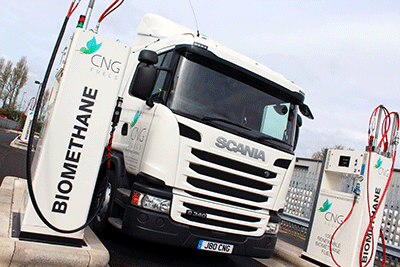
Having trialled many gas-powered vehicles in the past, including dual fuel, LPG, LNG, CNG and many more, trials have usually shown the same results: promising technology, easy to maintain, zero emissions and reduced fuel costs. However, and crucially for a company like Abbey Logistics, who count every penny of its fleet costs, and rely on the flexibility of our network; the vehicles have always been too expensive to buy and their mileage range has always been too low to be a viable alternative to diesel.
That was until now. Innovative new technology from Scania and Iveco means that liquid natural gas (LNG) and compressed natural gas (CNG) can now be used in vehicles that can achieve almost the same miles per tank as their diesel equivalents.
Trials
Abbey Logistics is now working with CNG Fuels, the UK’s leading operator of CNG, to run trials on new CNG vehicles. The trucks from Iveco and Scania will be put through their paces in a two-month trial, operating on the same routes carrying the same loads as their diesel counterparts to give us a clear picture of how they are performing.
One of the key benefits of conducting real world trials of new vehicles, especially ones which use new technology, is that our drivers have the opportunity to feedback how they are performing. Are they comfortable? Is safety and compliance affected in any way? Are there any other concerns that only emerge once the vehicle is out on the road? We conduct in-depth interviews with drivers to get their feedback, which is vital as it is our drivers who will be working with these vehicles every day.
Refuelling
Drivers involved in the trial will be trained to use the new refuelling pumps, which use a traffic light system that tells the driver when fuelling is complete and it takes no longer than filling up a diesel tank. Refuelling is also inherently safe and clean due to zero spillage and the driver doesn’t need to stand next to the vehicle during the process.
Additional benefits are obvious - minimised emissions and reduced fuel costs - and because the engines themselves are much simpler than modern diesel engines, maintenance costs should be reduced too.
While the latest CNG developments are exciting, we are reserving judgement until a full evaluation of the gas-powered vehicles is complete.
Whilst I’ve known about the potential benefits of gas power in HGVs for a long time, it is only now through these new engines that there is a real alternative to diesel emerging. I’m excited to understand how these trucks perform in the real world as the potential benefits to the environment and our cost base is significant. We will test them objectively and if we find that they perform as well or better than our current fleet, that will be a real game changing moment for Abbey and the wider industry.













